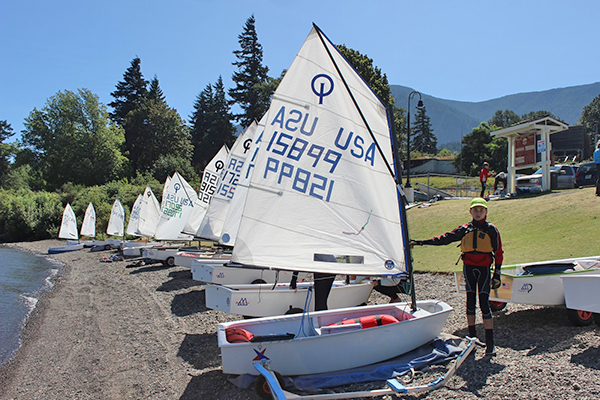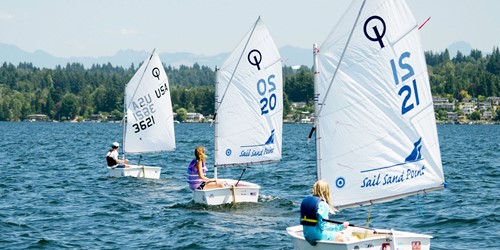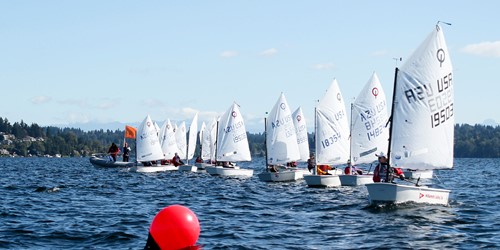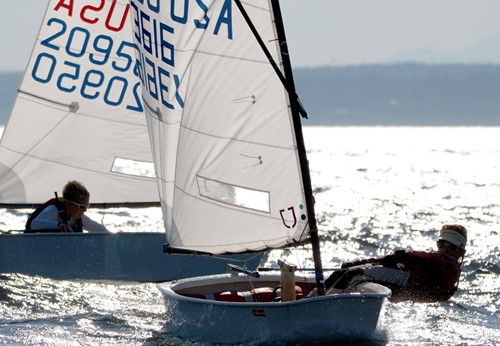
Getting Started!
Opti Green Fleet is a great entry level experience for novice racers. When is a sailor ready for Green Fleet? Generally if they can get around two buoys with minimal assistance they're ready for Green Fleet.
All Northwest Youth Racing Circuit events include an Opti Green Fleet, with the exception of the WIND Regatta. Green Fleet racing often takes place on a separate race course that is smaller and more protected. Green fleet usually enjoys a shorter day on the water and/or a lunch break mid way through racing. Coaching is permitted during racing for the back half of the fleet, and coaches are encouraged to coach everyone, not just their sailors. Many regatta hosts provide Optis free of charge, and/or offer a reduced entry fee for Green Fleet sailors. At some regattas it can be as easy as just showing up with a lifejacket and positive attitude!
There are no prizes or trophies for Green Fleet, instead sailors are given participation awards. Most Green Fleet sailors are between the ages 7-10. The only age restriction is that sailors must be younger than 15. Sailors generally do Green Fleet for one year, or until they are near the top of the fleet, before moving up to Championship Fleet. Switching back and forth between Green Fleet and Championship Fleet is discouraged. Click here to read the USODA Green Fleet Policy Statement.
In addition to the NWYRC Green Fleet events, there are other local green fleet style events to attend. The Milfoil Dodger series is popular among Seattle area sailing programs. They are casual one day regattas with an emphasis on fun and learning. Many novice racers will participate in both the Milfoils and Green Fleet at the NWYRC regattas. Milfoils are a great way to gain confidence and experience. The Milfoil Dodger Calendar is below...
Championship Fleet
When sailors are ready to move out of Green Fleet they move into the "Opti Championship Fleet." To make Optimist racing in the United States as fair as possible, the class puts each skipper into an age group or fleet. White Fleet is for skippers who are ages 10 and under. Blue Fleet is for skippers who are 11 or 12. Red Fleet is for skippers who are 13-15. At Northwest Youth Racing Circuit regattas white, blue, and red fleets are combined. However, overall series results are broken down into age groups. At the end of the summer the NWYRC recognizes the top finishers in each age group, plus an overall series champion.
"Aging Out" or "Sizing Out?"
On their 16th birthday sailors "age out" of the Optimist and are no longer allowed to compete in the class. However, most sailors "size out" before they "age out." Sailors will start to outgrow the Opti around 110lbs. For some sailors this happens sooner than others. Those who are very competitive may stick it out until they are 115lbs, but being competitive becomes increasingly difficult once you exceed this weight. My advice is to stay in the Opti as long as you are still having fun and feeling competitive. It's no fun to be the biggest sailor and get passed by everyone in light or medium wind. Before that happens, start thinking about what's next. Maybe that's the Laser with a smaller 4.7 rig or sailing an FJ with a friend.
Class Association
The United States Optimist Dinghy Association oversees Opti racing here in the US. The USODA is in charge of enforcing class rules, overseeing national/qualifying regattas, and selecting the US National Team. The USODA adheres to the rules and guidelines set forth by the International Optimist Dinghy Association. Opti sailors are strongly encouraged to join the USODA. Although USODA membership is not required for NWYRC events, it is required for championships, qualifiers, and team-trials. Membership is also a good way to support the class that supports you! On the USODA website you'll find lots of great resources!
The US National Team
The US National Team is run by the USODA. The purpose of the USNT is to improve the level of Optimist sailing in the United States, by providing high level training to top US Optimist sailors who compete internationally. The team receives the best coaching available and practices against the best sailors in the country. The team also tries to improve the fitness of sailors. It is funded by parents of participating sailors and does not impact the USODA budget. A sailor must first qualify for Team Trials by finishing in the top 20% of the USODA NW Championships or one of the country's other regional Opti championships. Team trials is arguably the most competitive Opti regatta in nation, since the best sailors from each region are all in attendance. The top forty-five (45) finishers at Team Trials are selected to the US National Team, which is an elite travel group that participates in international Opti regattas all over the globe.




